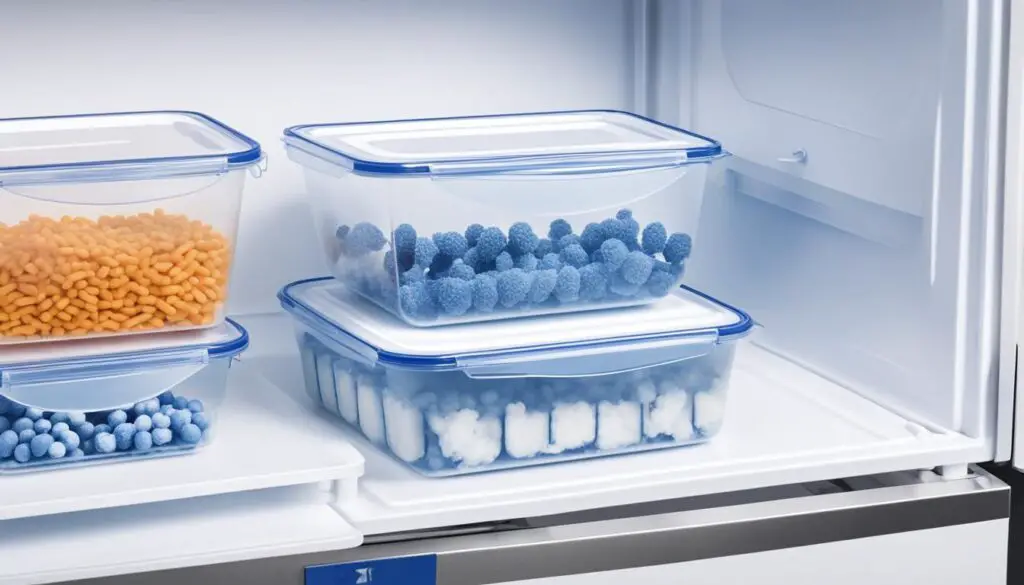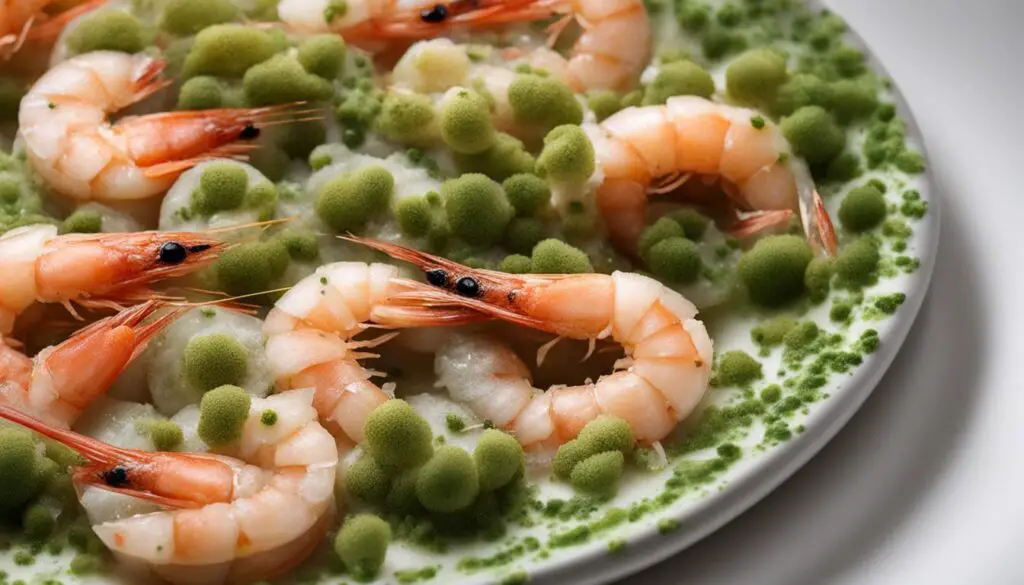When it comes to food safety, understanding proper storage guidelines is crucial. If you’ve ever wondered whether it’s safe to leave shrimp out overnight, we’re here to provide you with the facts.
Perishable foods, such as shrimp, should not be left out at room temperature for an extended period. According to food safety guidelines, bacteria can multiply rapidly at temperatures between 40°F and 140°F, which increases the risk of foodborne illness. Leaving shrimp out overnight can lead to bacterial growth and potential spoilage.
Key Takeaways:
- Leaving shrimp out at room temperature increases the risk of bacterial growth.
- Perishable foods, including shrimp, should not be left out for more than two hours.
- Proper storage in the refrigerator or freezer is crucial to maintain freshness and prevent spoilage.
- Following food safety guidelines helps minimize the risk of foodborne illness.
- Always refrigerate or freeze cooked shrimp promptly after cooking to ensure their safety and quality.
Proper Storage of Shrimp
After cooking shrimp, it is important to store them properly to maintain their quality and prevent bacterial growth. Cooked shrimp can be stored in the refrigerator for 3-4 days in a sealed airtight container.
If the shrimp have been exposed to temperatures above 90°F, they should be refrigerated within one hour. For longer-term storage, shrimp can be frozen for up to three months. It is recommended to wrap them tightly in plastic wrap, aluminum foil, or freezer bags to minimize freezer burn.
Proper thawing methods include thawing in the refrigerator or using the cold water method.
Proper storage of shrimp is crucial in maintaining freshness and preventing bacterial growth.
Preventing Bacterial Growth
To ensure food safety and prevent bacterial growth, it is crucial to avoid leaving shrimp at room temperature for an extended period. Bacteria thrive and multiply rapidly within the danger zone temperature range of 40°F to 140°F. Leaving shrimp out overnight creates an ideal environment for bacterial growth, significantly increasing the risk of foodborne illness.
Properly refrigerating cooked shrimp and following recommended storage guidelines are key in preventing spoilage and maintaining food safety. By promptly storing cooked shrimp in the refrigerator, you can minimize the time it spends in the danger zone. This helps to inhibit bacterial growth and preserve the quality of the shrimp.
“Leaving shrimp out overnight is like an invitation for bacteria to party on your plate.”
In addition to refrigeration, it is essential to handle shrimp with care throughout the entire cooking and storage process. Ensure that all preparation surfaces and utensils are thoroughly cleaned before and after handling shrimp, reducing the risk of cross-contamination. By following safe handling practices and refrigerating cooked shrimp promptly, you can prevent bacterial growth and enjoy shrimp without compromising your health.
In the next section, we will discuss the safe handling practices for storing shrimp and provide useful tips to maintain its freshness and quality.
Preventing Bacterial Growth: Key Points
- Avoid leaving shrimp at room temperature for an extended period to prevent bacterial growth.
- Bacteria multiply rapidly within the danger zone temperature range of 40°F to 140°F.
- Promptly refrigerating cooked shrimp inhibits bacterial growth and preserves quality.
- Handle shrimp with care to minimize the risk of cross-contamination.

Safe Handling of Shrimp
Proper handling of shrimp is essential to prevent seafood spoilage and maintain food safety. When purchasing shrimp, ensure they are fresh and properly stored at a safe temperature. After preparing and cooking shrimp, store them promptly in the refrigerator or freezer. Avoid cross-contamination by using separate cutting boards and utensils for raw and cooked shrimp. It is also important to follow safe thawing methods to prevent bacterial growth. By practicing safe handling and storage techniques, you can reduce the risk of foodborne illness and enjoy fresh, flavorful shrimp.
Purchasing and Storing Fresh Shrimp
When buying shrimp, look for those that have a firm texture, bright color, and a mild sea-like odor. Avoid shrimp with a slimy texture or strong ammonia smell, as these can be signs of spoilage. If purchasing frozen shrimp, ensure there are no ice crystals or signs of freezer burn.
Properly store fresh shrimp by refrigerating them immediately after purchase. Ideally, keep them in an airtight container or sealed plastic bag to prevent odor transfer and maintain their freshness. Refrigerated shrimp should be consumed within two days to ensure their quality.
If you don’t plan to consume the shrimp within two days, it’s recommended to freeze them for longer-term storage.
Safe Handling and Storage Techniques
- Wash your hands thoroughly with soap and water before and after handling raw shrimp to prevent cross-contamination.
- Use separate cutting boards and utensils for raw and cooked shrimp to avoid spreading bacteria.
- Clean all surfaces, utensils, and cutting boards with hot, soapy water after handling raw shrimp.
- Refrigerate or freeze cooked shrimp promptly after preparing them.
- Avoid leaving cooked shrimp at room temperature for extended periods, as this can promote bacterial growth.
- Follow safe thawing methods by thawing shrimp in the refrigerator or using the cold water method.

By following these safe handling and storage techniques, you can minimize the risk of seafood spoilage and ensure the longevity of your shrimp. Proper handling and storage practices help maintain the quality, flavor, and safety of seafood, allowing you to enjoy delicious shrimp without any concerns.
Storing Shrimp in the Refrigerator
Properly refrigerating cooked shrimp is crucial for maintaining their freshness and preventing bacterial growth. Follow these seafood storage tips to store shrimp in the refrigerator:
- Store cooked shrimp in the refrigerator within two hours of cooking.
- Use a sealed airtight container to maintain freshness and prevent odor transfer.
- If shrimp have been exposed to temperatures above 90°F, refrigerate them within one hour to minimize the risk of bacterial growth.
- Storing cooked shrimp in the refrigerator allows for convenient meal preparation and can keep them safe for 3-4 days.
By refrigerating shrimp properly, you can enjoy them later while ensuring food quality and safety.
Benefits of Storing Shrimp in the Refrigerator
There are several benefits to storing cooked shrimp in the refrigerator:
- Convenient meal preparation: Having stored shrimp readily available in the refrigerator makes meal planning and cooking quick and easy.
- Prolonged freshness: The cold temperature of the refrigerator helps slow down bacterial growth, keeping the shrimp fresher for longer.
- Reduced food waste: Properly refrigerating shrimp allows you to save leftovers and minimize food waste.
- Enhanced food safety: Storing shrimp in the refrigerator prevents the growth of harmful bacteria and reduces the risk of foodborne illnesses.
Remember to always follow seafood storage tips to maintain the quality and safety of your shrimp.
| Storage Method | Temperature | Storage Duration |
|---|---|---|
| Refrigerator | 32°F – 40°F (0°C – 4°C) | 3-4 days |
| Freezer | 0°F (-18°C) | Up to 3 months |
Properly stored shrimp will stay fresh and safe to consume, ensuring you can enjoy delicious seafood with peace of mind.
Freezing Shrimp for Longer Storage
When it comes to extending the shelf life of shrimp, freezing is a highly effective method. By properly freezing cooked shrimp, you can keep them for up to three months without compromising their quality. Here are some essential seafood storage tips to ensure successful freezing and maintain the freshness of your shrimp:
- Tightly wrap the shrimp: To prevent freezer burn and protect the shrimp from moisture loss, wrap them tightly in plastic wrap, aluminum foil, or freezer bags before placing them in the freezer.
- Label with freezing date: To stay organized, label the wrapped shrimp with the date of freezing. This will help you keep track of their freshness and ensure you use the oldest ones first.
Now that you have properly frozen your shrimp, it’s important to know the correct thawing methods to maintain their quality. There are two recommended methods for thawing frozen shrimp:
- Refrigerator thawing: Place the frozen shrimp in the refrigerator and allow them to gradually thaw overnight. This slow thawing process helps retain their texture and flavor.
- Cold water thawing: If you need to thaw the shrimp quickly, you can use the cold water method. Place the tightly sealed shrimp in a leak-proof bag and submerge them in cold water. Change the water every 30 minutes until the shrimp are fully thawed.
Whether you want to enjoy shrimp at a later date or have a convenient option for future meals, freezing shrimp is a great way to extend their shelf life. Just remember to follow these seafood storage tips, including proper wrapping and labeling, to ensure your frozen shrimp remain fresh and free from seafood spoilage.
Conclusion
In conclusion, it is essential to follow proper food safety guidelines when it comes to the storage of shrimp. Leaving shrimp out overnight is not recommended due to the risk of bacterial growth and spoilage. To maintain their freshness and prevent the risk of foodborne illness, it is crucial to refrigerate cooked shrimp within two hours of cooking.
Proper storage of shrimp in the refrigerator or freezer can help prolong their shelf life. Cooked shrimp should be stored in a sealed airtight container in the refrigerator for 3-4 days. If the shrimp have been exposed to temperatures above 90°F, it is advised to refrigerate them within one hour to prevent bacterial growth.
By practicing safe handling and storage techniques, you can enjoy shrimp while ensuring food safety. Remember to always follow proper storage guidelines and avoid leaving perishable foods, including shrimp, at room temperature for too long. When in doubt, it is better to be cautious and prioritize food safety to protect yourself and your loved ones.
FAQ
Can shrimp be left out overnight?
According to food safety guidelines, perishable foods, including shrimp, should not be left out at room temperature for more than two hours. Leaving shrimp out overnight can lead to bacterial growth and potential spoilage.
What is the proper storage of shrimp?
After cooking shrimp, it is important to store them properly to maintain their quality and prevent bacterial growth. Cooked shrimp can be stored in the refrigerator for 3-4 days in a sealed airtight container. For longer-term storage, shrimp can be frozen for up to three months.
How can I prevent bacterial growth when storing shrimp?
To prevent bacterial growth and ensure food safety, it is essential to avoid leaving shrimp at room temperature for an extended period. Properly refrigerating cooked shrimp and following recommended storage guidelines is crucial in preventing spoilage and maintaining food safety.
What are some safe handling tips for shrimp?
Proper handling of shrimp is essential to prevent seafood spoilage and maintain food safety. When purchasing shrimp, ensure they are fresh and properly stored at a safe temperature. After preparing and cooking shrimp, store them promptly in the refrigerator or freezer.
How should I store shrimp in the refrigerator?
Cooked shrimp should be stored in the refrigerator within two hours of cooking. It is recommended to use a sealed airtight container to maintain freshness and prevent odor transfer. Storing cooked shrimp in the refrigerator allows for convenient meal preparation and can keep them safe for 3-4 days.
Can I freeze shrimp for longer storage?
Freezing shrimp is an effective method for longer-term storage. Cooked shrimp can be frozen for up to three months while still maintaining quality. It is important to wrap the shrimp tightly in plastic wrap, aluminum foil, or freezer bags to prevent freezer burn.
What is the conclusion about leaving shrimp out overnight?
In conclusion, it is not safe to leave shrimp out overnight due to the risk of bacterial growth and spoilage. By practicing safe handling and storage techniques, you can enjoy shrimp while ensuring food safety.

